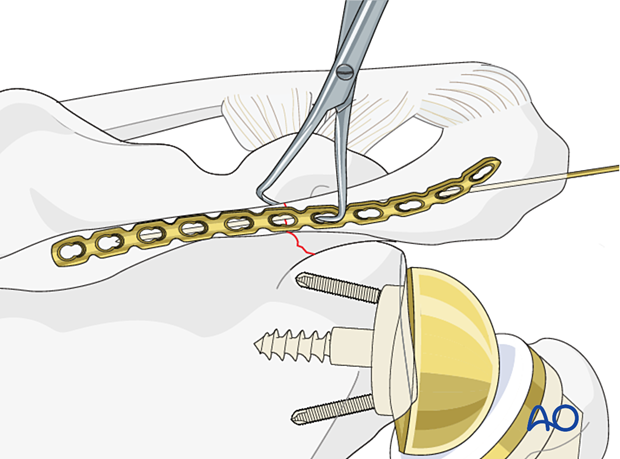ORIF - Reconstruction plate fixation
1. Introduction
In the setting of a reverse total shoulder replacement, fractures of the base of the acromion and scapula spine may be managed non-operatively. However, with painful displacement and persistent functional deficits, open reduction and internal fixation (ORIF) is advocated.
With a reverse prosthesis, there may be more tension on the deltoid muscle due to lengthening of the arm and the forces acting on the acromion fragment are greater. In this setting multiplanar fixation is recommended.

Plate options
Different types of plate can be used depending on bone quality, fracture location, and surgeon preference. Options include:
- 3.5 mm Locking compression plate system
- 2.7 mm Locking compression plate system

2. Patient preparation
Depending on the approach, this procedure may be performed with the patient in the beach chair position at 30º or the lateral decubitus position.
Patient positioning should be discussed with the anesthetist.
3. Approach
An extended superior scapular approach is performed.

4. Reduction and fixation
Reduction
Reduction can be achieved using reduction clamps.

Provisional fixation
Holding the reduction with a K-wire is an option.

Plate length and contouring
Preoperative planning is crucial to determine optimal plate length and position.
The scapular spine is very narrow. Extending the plate length medially will enhance construct stability.
There is a predictable twist between the spine of scapula and plane of the acromion which is accommodated by precontouring the fixation plate.
In-plane anterior bending of the distal acromial part of the plate also facilitates plate-bone contact.

Screw length and direction
Preoperative planning is crucial to determine screw length and direction. The scapular spine is very narrow and it is easy to miss the bone.
Depending on the implant used, divergent locking screws in the acromion provide optimal pullout resistance.
Planning is best performed with CT scans.
- Patient-specific guides can be a useful tool to improve screw placement
- An independent lag screw can add stability in a second plane
- A second plate positioned orthogonal to the first can also add stability

Screw insertion
Screws are inserted sequentially in both main fragments (at least three screws per side), to achieve balanced fixation.
Longer screws are used in the medial region and shorter screws are used in the acromial region because of the anatomy of the bone.

Check the reduction and temporary fixation with an image intensifier.

5. Aftercare
Postoperative phases
The aftercare can be divided into four phases of healing:
- Inflammatory phase (week 1–3)
- Early repair phase (week 4–6)
- Late repair and early tissue remodeling phase (week 7–12)
- Remodeling and reintegration phase (week 13 onwards)
Full details on each phase can be found here.













